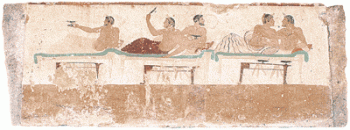American Journal of Archaeology | The Journal of the Archaeological Institute of America
You are here
The Tomb of the Diver
July 2006 (110.3)
The Tomb of the Diver
Dating from about 470 B.C., the frescoes of the Tomba del Tuffatore (Tomb of the Diver) at Paestum are the only example of Greek wall painting with figured scenes from the Orientalizing, Archaic, or Classical periods to survive in their entirety. Close examination of the paintings shows the working practices of the artists. Technically these are similar to those of the painters of Etruscan tombs of the period. There is a world of difference, however, between the purpose and conceptualization of Etruscan tomb painting and that revealed in the Tomb of the Diver. Furthermore, although interpretations claiming Orphic or Pythagorean significance have been advanced, reconsideration of the frescoes gives some reason to think that the program for the tomb’s decoration may have been of the simplest nature and developed by the artists themselves from prototypes in Attic vase painting available to them in Italy. Thus, although the diver may make reference to the moment of death and the symposium may have been intended to create a welcoming scene to surround the dead man in the tomb, the creation of these frescoes may owe more to the initiative of the painters than to any complexities of philosophy.
By R. Ross Holloway
American Journal of Archaeology Vol. 110, No. 3 (July 2006), pp. 365–388
DOI: 10.3764/aja.110.3.365
© 2006 Archaeological Institute of America


